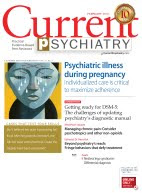Sy Atezaz Saeed, MD, Professor and chair, Department of psychiatric medicine, Brody School of Medicine at East Carolina University, Greenville, NC
Richard M. Bloch, PhD, Professor and director of research, Department of psychiatric medicine, Brody School of Medicine at East Carolina University, Greenville, NC
Diana J. Antonacci, MD, Associate professor and director of residency training, Department of psychiatric medicine, Brody School of Medicine at East Carolina University, Greenville, NC
C. Ervin Davis, III, PhD, Assistant professor, department of psychology, Adjunct assistant professor of psychiatry, Department of psychiatric medicine, Brody School of Medicine at East Carolina University, Greenville, NC
Crystal Manuel, MD, Assistant professor, Department of psychiatric medicine, Brody School of Medicine at East Carolina University, Greenville, NC
Americans with depression turn to complementary and alternative medicine (CAM) more often than conventional psychotherapy or FDA-approved medication. In a nationally representative sample, 54% of respondents with self-reported “severe depression”—including two-thirds of those receiving conventional therapies—reported using CAM during the previous 12 months.
Unfortunately, popular acceptance of CAM for depression is disproportionate to the evidence base, which—although growing—remains limited. As a result, your patients may be self-medicating with poorly supported treatments that are unlikely to help them recover from depression.
In reviewing CAM treatments for depression, we found some with enough evidence of positive effect that we feel comfortable recommending them as evidence-based options. These promising, short-term treatments are supported by level 1a or 1b evidence and at least 1 study that demonstrates an ability to induce remission.


What about phototherapy? A 2005 meta-analysis showed that light therapy (10,000 lux for 1 hr per day) improved depressive symptoms NOT ONLY in seasonally depressed patients, but all depressed patients. VGT, MD; New York City
ReplyDelete